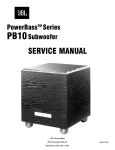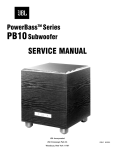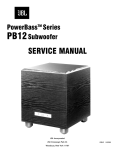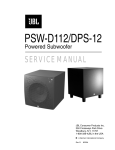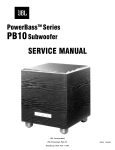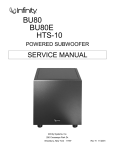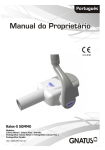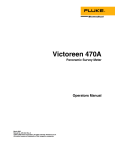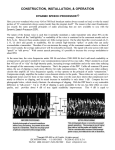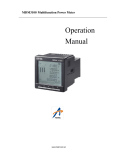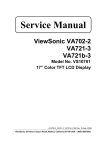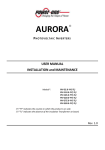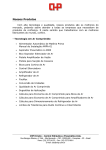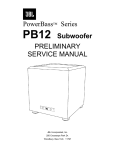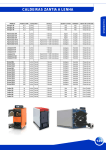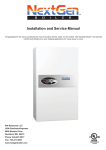Download BU-150
Transcript
BU-150 Powered Subwoofer SERVICE MANUAL Infinity Systems Inc. 250 Crossways Park Drive Woodbury, N.Y. 11797 1-800-553-3332 A Harman International Company Rev A 3/2000 Amplifier/Subwoofer SAFETY INFORMATION BU-150 Warning Leakage/Resistance Check Any person performing service of this unit will be exposed to hazardous voltages and the risk of electric shock. It is assumed that any person who removes the amplifier from this cabinet has been properly trained in protecting against avoidable injury and shock. Therefore, any service procedures are to be performed by qualified service personal ONLY! Before returning the unit to the customer, perform a leakage or resistance test as follows: Caution This unit does not have a power switch. Hazardous voltages are present within the unit whenever it is plugged in. Before the amplifier is plugged in, be sure its rated voltage corresponds to the voltage of the AC power source to be used. Incorrect voltage could cause damage to the amplifier when the AC power cord is plugged in. Do not exceed rated voltage by more than 10%: operation below 90% of rated voltage will cause poor performance or may shut the unit off. Leakage Current. Note there is no power switch on this unit. When the power plug is plugged in, the unit is live. Connect the unit to its rated power source. Using an ammeter, measure the current between the neutral side of the AC supply and chassis ground of the unit under test. if leakage current exceeds 0.5mA, the unit is defective. Reverse the polarity of the AC supply and repeat. Resistance. Measure the resistance from either side of the line cord to chassis ground. If it is less than 500k ohms, the unit is defective. WARNING! DO NOT return the unit to the customer if it fails one of these tests until the problem is located and corrected. List of Safety Components Requiring Exact Replacements F1 Fuse SLO BLO 1.5A 250V 20mm. UL approved PWRCORD SPT-2 or better with polarized plug, UL approved wired with the hot side to fused side. Use with factory replacement panel strain relief only. T1 Transformer. Use only factory replacement. DBR Bridge diode. Use only factory replacement. C1, 2 2200uF, 100V electrolytic filter caps. Be sure replacement part is at least the same working voltage and capacitance rating. Also the lead spacing is important. Incorrect spacing may cause premature failure due to internal cabinet pressure and vibration. C6 4.7uF 100V electrolytic radial S64AMI Power output module. Use only factory replacement Faceplate Faceplate. Use only factory replacement Air leak cover Use only factory replacement CMC1 Use only factory replacement L1 Use only factory replacement Fuse PCB Use only factory replacement Main PCB Use only factory replacement 2 BU-150 Amplifier/Subwoofer TABLE OF CONTENTS SAFETY INFORMATION ..................................................2 BU-150 AMPLIFIER ASSEMBLY EXPLODED VIEW....15 GENERAL SPECIFICATIONS..........................................3 BU-150 PCB (Version 3.52) Component Side Trace ....16 DETAILED SPECIFICATIONS .........................................4 BU-150 PCB (Version 3.52) Solder Side Trace ............17 CONTROLS AND THEIR FUNCTION .............................6 BU-150 PCB (Version 3.53) Component Side Trace ....18 BU-150 CONNECTIONS .................................................7 BU-150 PCB (Version 3.53) Solder Side Trace ............19 OPERATION ...................................................................11 BU-150 ELECTRICAL PARTS LIST ..............................20 BU-150 TEST SET UP AND PROCEDURE..................12 BU-150 INTEGRATED CIRCUIT DIAGRAMS ...............21 BU-150 POWER AMP MODULE TESTING FLOW CHART ................................................................13 BU-150 SCHEMATIC 1 of 2...........................................22 BU-150 SCHEMATIC 2 of 2...........................................23 BU-150 PACKING & CABINET ASSEMBLY .................14 GENERAL SPECIFICATIONS Frequency Response (63dB) . . . . . . . . . . . . . . . . . 28Hz – 150Hz Output (RMS). . . . . . . . . . . . . . . . . . . . . . . . . . . . . 200W Driver . . . . . . . . . . . . . . . . . . . . . . . . . . . . . . . . . . 15" Woofer Crossover Frequency . . . . . . . . . . . . . . . . . . . . . . . 50Hz ~ 150Hz (continuously variable) Dimensions (H x W x D) . . . . . . . . . . . . . . . . . . . . . 17 ) " x 17 ) " x 17 ) " (451 x 451 x 451mm) Add 1) " (4.5cm) for feet. Weight. . . . . . . . . . . . . . . . . . . . . . . . . . . . . . . . . . 55 lbs/20 kg Refinements may be made on occasion to existing products without notice, but will always meet or exceed original specifications unless otherwise stated. 3 Amplifier/Subwoofer LINE VOLTAGE US 120vac/60Hz Parameter BU-150 DETAILED SPECIFICATIONS Yes/ No Yes Hi/Lo Line Nom. Unit Notes 108-132 120 Vrms Normal Operation Spe cific atio n Unit Test Limits Conditions Notes Class D Preferred...Sink required for Class AB Z-curve required Amp Section Type (Class AB, D, other) Load Impedance (speaker) Rated Output Power THD 8 Ohms n/a Nominal 200 1 Watts % 120 2 1 input driven 22k filter THD @ 1 Watt DC Offset Damping factor 0.5 <20 >80 % mV-DC DF 0.5 30 >50 22k filter @ Speaker Outputs Input Sensitivity Input Frequency Line Input 35 265 Hz mVrms ±2dB Speaker/Hi Level Input 7 Vrms ±2dB Signal to Noise SNR-A-Weighted 100 dBA 90 SNR-unweighted 75 dBr 70 SNR rel. 1W-unweighted 65 (22k) Residual Noise Floor 2 dBr 55 mVrms 3 Residual Noise Floor 1.5 mVrms(max) 2 Input Impedance Line Input Speaker/Hi Level Input 10K 5K ohms ohms n/a n/a Filters Low Pass (fixed or variable) Low Pass filter (point or range) Slope Q Subsonic filter (HPF) Slope Q Varia ble 60-1 80 24 1 25 12 1 D n/a Input voltage 120 VAC, 60 Hz 120W (Power Bandwidth 30-100Hz) @ 120 VAC Measured across amplifier outputs Nominal Freq. To Rated Power/ Vol @ Max To Rated Power/ Vol @ Max 1 input driven 1 input driven: AP source Z = 600 ohms 1 input driven: AP source Z = 25 ohms Relative to rated A-Weighting filter output Relative to rated 22k filter output relative to 1W 22k filter Output Volume @max, using RMS reading DMM/VOM (or A/P) , BW <20KHz Volume @max, w/ A/P Swept Bandpass Measurement (Line freq.+ harmonics) , BW<20Khz Nominal Nominal 0dBr = 1w @ 50Hz Hz ±2dB -3dB Point dB/Octave Damping Hz dB/Octave Damping n/a n/a ±2dB n/a n/a -3dB Point 4 BU-150 Amplifier/Subwoofer Limiter (yes/no) THD at Max. Output Power Features Phase Switch (yes/no) Volume pot Taper (lin/log) yes 10 % functional ck. YES — functional ck. functional ck. LOG — Input Configuration Line In (L&R) LR — — Spkr/Hi Level In L,R — 100 Hz (L&R) Spkr Out: Hi Pass Filter Signal-Present LED Yes Signal-Present Input 35 Freq. Signal-Present Level line 30 in functional ck.. functional ck.. functional ck.. Maximum Output Power Maximum THD as a result of limiting. 45 deg additional phase shift/switch op.OK Enabled w/Line/Spkr Input Select Switch 8 ohm Satellite: 6dB/oct passive xover 200 Uf cap. Non polarized Hz Nominal mV Zo=600 Ohms 35Hz into Line Input w/ 1 ch. Driven 35Hz into Speaker Input w/ 1 ch. Driven Amp connected and AC on, then input signal applied T before muting, after signal is removed Signal-Present Speaker -in 2.6 V Signal-Present Turn-on time Auto Mute/ Turn-OFF Time 1 sec. >3 min. Power on Delay time 1 sec. 3 AC Power Applied Transients/Pops Signal-Present Transient Turn-on Transient 5 1 mV-peak mV-peak n/a 2v-pp Turn-off Transient 2 mV-peak 4v-pp @ Speaker Outputs @ Speaker Outputs AC Line cycled from OFF to ON @ Speaker Outputs AC Line cycled from ON to OFF Efficiency Stand-by Input Power 20 Watts 28 210 Watts 220 95.2 4% % 54.55% Amps functional ck.. functional ck.. 2 Power Cons.@rated power Efficiency Protection Short Circuit Protection YES Thermal Protection YES Line Fuse Rating 2 @ nom. line voltage @ nom. line voltage Relative to rated output Direct short at output @1/8 max unclipped Power Input Line voltage 120 VAC Power transformer 85 deg C. Slo-Blo type 5 BU-150 Amplifier/Subwoofer CONTROLS AND THEIR FUNCTION 1. High-Level input and Output terminals SPKR IN SPKR OUT 2. Low-Level Input Jacks: connect to preamplifier outputs 3. Low Pass: This is the crossover frequency control which determines the upper-corner roll-off points. 1 4. Power-On indicator 5. Phase: 0/180 switch to change audio-signal polarity. R R L L 6. Level: This controls the volume level of the subwoofer. 2 3 4 5 6 L R Line Input Low Pass 50 Phase 0o 150 Power 180o Level Min Max Digital Technology BU-150 Powered Subwoofer 120V 60Hz 250W CAUTION RISK OF ELECTRIC SHOCK DO NOT OPEN TO REDUCE THE RISK OF ELECTRIC SHOCK. DO NOT EXPOSE THIS EQUIPMENT TO RAIN OR MOISTURE 6 Amplifier/Subwoofer BU-150 CONNECTIONS BU-150 When connecting your subwoofer make sure you turn all the power off. There are several ways to connect your subwoofer. Read this section carefully to determine which method is best suited for your installation. The subwoofer may be fed directly with a low-level signal taken from a preamplifier's output by using the second set of output jacks on the rear of the preamplifier (See Figure 1). If a preamplifier has only one set of outputs, you may use two (2) “Y” connectors (See Figure 2) to connect the subwoofer. Use standard shielded leads terminated at each end with male RCA connectors. Connect one end of each stereo pair of leads to the preamplifier's left and right outputs and connect the other end to the corresponding left and right LOW-LEVEL INPUTS (1) on the subwoofer. If you are using a tube preamplifier and the connecting leads will be longer than 10 feet (3 meters), we recommend not using the above connection method. A tube preamplifier may not be able to handle the capacitance introduced by leads more than 10 feet in length. Instead, try using the high-level connection methods listed on pages 5-7. Figure 1. - A low-level signal can be used from a preamp's output by connecting second set of output jacks to the rear of your amplifier. Figure 2. - You can use this method (2“Y” connectors) if your preamp has only one set of outputs. 7 Amplifier/Subwoofer BU-150 When using a single subwoofer, you MUST use a pair of stereo low-level leads from your preamplifier's outputs. When using two subwoofers, one for the left and another for the right channels, connect the left preamplifier output to BOTH the left and right LOW-LEVEL INPUTS of the subwoofer used for the left channel by using a Female-to-Male “Y” connector at the subwoofer's output. Connect the right-channel preamplifier output to both jacks of the right-channel subwoofer in the same manner (See Figure 3). If the preamplifier has a mono subwoofer output, you'll also need a Male-to-Female “Y” connector to split the mono signal to the subwoofer pair (See Figure 3). Figure 3. - Use this method when using single subwoofer or two subwoofers. The subwoofer may be connected to your system using the HIGH-LEVEL INPUTS (4) on the plate located on the rear panel of the subwoofer. Use speaker wire, maintaining proper polarity (+ to + and - to -). Attach the speaker wire to the left and right HIGH-LEVEL INPUTS on the subwoofer and the other ends to the proper left and right OUTPUTS on your amplifier or receiver (See Figure 4). If you plan to use two subwoofers (one for the left and the other for the right channel), connect wires from the left and right OUTPUT on your power amplifier or receiver and attach the other ends to the corresponding HIGH-LEVEL INPUTS on each subwoofer. Observe polarity (See Figure 6). Figure 4. - Use this method when using a single subwoofer. 8 Amplifier/Subwoofer BU-150 Figure 5. - Use this method when using two subwoofers. Figure 6. - Use this method when connecting one subwoofer to satellites. Depending on whether you are using one or two subwoofers, connecting your satellites can be accomplished in one of two ways. If you are using a single subwoofer with a pair of satellites, connect them as shown in Figure 7. 9 Amplifier/Subwoofer BU-150 Figure 7. - Use this method when connecting two subwoofers to satellites. If you are using two subwoofers as a stereo pair with a pair of satellites, connect them as shown in Figure 7. The subwoofer has a variable frequency control that can be used to block unwanted frequencies (between 50 - 150Hz) from being reproduced by the subwoofer. When you set this control depends on the low-frequency capabilities of your satellite speakers. Adjust this knob to the lowest frequency that you satellite speakers were designed to reproduce (refer to Operation, step 7). 10 Amplifier/Subwoofer OPERATION BU-150 Setting the Controls Room Placement 1. Initially set the subwoofer's Volume control to the minimum position. 8. The room placement of the subwoofer is the most critical aspect of its installation. It will be necessary for you to try various locations in your listening room before you choose the final location. Some possible starting points include: behind the right channel satellite speaker, along the back wall between the satellites, along a side wall (but not too close to a corner), or behind a couch or a chair. 2. Initially set the subwoofer's Crossover Frequency control to 12 o'clock. 3. Set the subwoofer's Phase switch to the “NOM” position Turn the Power On 4. Turn on the entire source. audio system and play any music 5. Turn the Volume control to its mid position. If no sound emanates from the subwoofer, check the AC line cord and input cables. Are the connectors on the cables making proper contact? Is the AC plug connected to a “live” receptacle? Adjusting the Volume 6. Set the overall volume control of the preamplifier or stereo to a comfortable level. Adjust the subwoofer's Volume control until you obtain a pleasing blend of bass. Bass response should not overpower the room but rather be adjusted so there is a harmonious blend across the entire musical range. Many users have a tendency to set the subwoofer volume too loud following the belief that a subwoofer is there to produce lots of bass. This is not entirely true. A subwoofer it there to enhance bass, extending the response of the entire system so the bass can be felt as well as heard. However, overall balance must be maintained; otherwise, the music will not sound natural. An experienced listener will set the volume of the subwoofer so its impact on bass response is always there but is never obtrusive. The Crossover Frequency Controls 7. The Crossover Frequency control sets the high-frequency roll-off, adjustable from 50 to 150Hz. Where you set this control depends on the low-frequency capabilities of your satellite speakers, system placement, and other factors affecting the mid-bass region. Turn the control UP (clockwise) until you feel there is too much mid-bass information (around 100Hz), then back the control down a bit until that area sounds more natural. To hear more low bass, turn the Crossover Frequency control DOWN a bit and the Volume control UP by about the same amount. This will increase low bass while leaving the mid-bass sounding the same as it did before the adjustment. To reduce low bass without changing midbass, turn the Crossover Frequency control UP and the Volume control DOWN. Switch the Phase switch between “NOM” and “REV” positions while listening to music. The selection that sounds the best is the correct adjustment for your system. In general, the closer the subwoofer is to wall and corners, the greater the effect of low-frequency enhancement. Experiment with the Crossover Frequency and Volume controls in different locations until you are pleased with the result you obtain from your particular application. A Word of Advice The Low-Frequency Roll-off and Volume controls may be set anywhere within their rotation. However, it will be a most unusual circumstance if you have to set the Volume control completely clockwise. This may indicate an unbalanced condition in your system (too much bass) or an especially large room, or room placement may not be correct. Try several other locations before concluding that the Volume control must be set at maximum. A Word About Tone Controls The tone controls on your electronic components (preamplifier, receiver, etc.) should be used with the utmost discretion. Excessive boost can create severe power demands on your power amplifier. Maximum bass boost can create a demand for literally hundreds of watts in the bass region, whereas in the “flat” position, or with the tone controls switched out of the system, your average listening level may be impressively and realistically loud at less than 10 watts. The remaining power capacity required is on reserve for power peaks on sharp transients and powerful crescendos. 11 Amplifier/Subwoofer BU-150 BU-150 TEST SET UP AND PROCEDURE AC VOLT METER ( 6V ) BU-150 UNDER TEST CD PLAYER SPKR IN SPKR OUT LINE LEVEL OUTPUT FROM AMPLIFIER PRE AMP R R L L FROM PRE AMP AMPLIFIER L R Line Input SPEAKER LEVEL Low Pass 50 Phase General Function Turn on generator, adjust to 50mV, 50 Hz. 3. Plug in UUT; red LED should be ON. Turn VOLUME control full clockwise. Low Pass control should be set fully clockwise (150) 4. LED should turn Green; immediate bass response should be heard and felt from port tube opening. 5. Turn off generator, turn VOLUME control fully counterclockwise, disconnect RCA cables. 6. Connect one pair of speaker cables to either high level input terminal on UUT. Cables should be connected to an integrated amplifier fed by the signal generator. 7. Turn on generator and adjust so that speaker level output is 2.0V, 50 Hz. Turn VOLUME control full clockwise. 8. Green LED should light, immediate bass response should be heard and felt from the port tube opening. Power 180o Level UUT = Unit Under Test 1. Connect both right and left line level inputs (RCA) to signal generator and UUT. Use Y-cable if necessary from mono source. VOLUME control should be full counterclockwise. 2. 0o 150 Min Max Digital Technology BU-150 Powered Subwoofer 120V 60Hz 250W CAUTION RISK OF ELECTRIC SHOCK DO NOT OPEN TO REDUCE THE RISK OF ELECTRIC SHOCK. DO NOT EXPOSE THIS EQUIPMENT TO RAIN OR MOISTURE Sweep Function 1. Follow steps 1-4 above, using a sweep generator as a signal source. 2. Sweep generator from 20Hz to 300Hz. Listen to the cabinet and drivers for any rattles, clicks, buzzes or any other noises. If any unusual noises are heard, remove driver and test. Driver Function 1. Remove driver from cabinet; detach + and - wire clips. 2. Check DC resistance of driver; it should be 6.4 ohms. 3. Connect a pair of speaker cables to driver terminals. Cables should be connected to an integrated amplifier fed by a signal generator and adjust so that speaker level output is 5.0V. 4. Sweep generator from 20Hz to 1kHz. Listen to driver for any rubbing, buzzing, or other unusual noises. 12 BU-150 Amplifier/Subwoofer BU-150 POWER AMP MODULE TESTING FLOW CHART START Check V+, V-, +/-15V voltage to module Resistance check between V+ V- and O/P O/P to GND should > 5K No OK Yes No OK Replace Module Check transformer, CMC, rectifier, C1, C2, D9, D10, R16, R17 Check 6V to module measure to V- Yes No Power up with no signal I/P LED RED OK Check D6, R9, R46 Yes Check fuse transformer, CMC, rectifier, C1, C2 No OK Yes Check I/P of module to GND 0V D.C. Check S/D voltage to module (5V) measure to VNo OK No OK Yes Check switching frequency 100KHz H +/-10% ~1Vpp Check C29 and Pre-AMP Check D1, R1, Q3, Q4, Q5 and SCP Yes Check O/P to module for 80Vpp square wave measure to GND No OK Yes No OK Yes Check L1, L2, L3, L4, C6, C24 Power AMP OK END 13 Amplifier/Subwoofer BU-150 PACKING & CABINET ASSEMBLY BU-150 SCREWS (4) FEET PART (Set of 4) #200310 FOOT BASE (Each) #200870 BU-150 CABINET ASSEMBLY SCREWS (8) TRIM RING #200401 15" WOOFER #200400 CABINET NOT FOR SALE SCREWS (10) TOP STYROFOAM COVER PAD #200465 SP KR OU T R SP KR IN R L L L Lin Lo Pa w ss Ph as 50 e 15 0o Le R e Inp ut ve Mi Pow CA REDU EXPO RISK CE SE THE THIS Po l BU -15 Digita 0 l Ma UT OF DO ELEC NOT TRIC we r n Tec ere hno IO N x logy d Sub 120 60HV 250 z W TO 0 180o wo ofe RISK OPENSHOC EQUI OF PMENELEC K T TO TRIC RAIN SHOC OR K. MOISDO NOT TURE r TOP STYROFOAM RAIL PADS (2 per carton) #200460 AMPLIFIER ASSEMBLY BU-150 SUBWOOFER FEET PAD (4) STICKERS #200252 PLASTIC BAG WARRANTY CARD #333715-001 OWNER'S MANUAL #200230 BU-150 PACKING BU OW -15 0 MANER NU 'S AL BOTTOM STYROFOAM RAIL PADS (2 per carton) #200470 BOTTOM STYROFOAM CENTER PAD #200475 CARTON #200420 14 BU-150 Amplifier/Subwoofer BU-150 AMPLIFIER ASSEMBLY EXPLODED VIEW A C B 5 1 D Ref.# R L 2 2 70317 Face Plate (Aluminum) SAFETY PART 1 3 70318 PCB Support SAFETY PART 1 4 70150 Phase Switch 1 5 70170 #4 x 0.5" Screws to secure input jacks 5 6 70171 #10 x 1" machine screw Bolts 4 5 7 70172 #10 Keps Nut 4 13 8 70173 #6 x 0.5" Screws for fuse PCB 2 9 80124 Transformer MCI4700 SAFETY PART 1 10 80123 250V, 1.5A, T type SLO BLO Fuse SAFETY PART 1 11 80112 Motherboard SAFETY PART 1 12 108115 High level input and output terminals 1 13 108320 Dual RCA input jacks 1 14 70305 Pwr Cord Strain Relief SAFETY PART 1 15 80105 Power cord, 2 conductor SAFETY PART 1 12 L 5 2 L R Line Input 1 Low Pass 50 4 Phase 3 150 Power 0o 180o 1 Level Min Max BU-150 Amplifier Assembly Exploded View 7 4 Qty Knobs SPKR IN R Description Part # A70302 1 SPKR OUT E 9 1 2 3 4 10 3 5 11 14 6 5 6 15 6 7 A 7 2 B C D E 15 Amplifier/Subwoofer 2 3 4 5 2 3 4 5 BU-150 F C D E Version 3.52 - Component Side Trace Layer 1 A A B B C D E F G G 1 BU-150 PCB (Version 3.52) Component Side Trace 16 D E F E F G 5 5 D 4 4 C 3 1 3 B G 2 A C Version 3.52 - Solder Side Trace Layer as viewed through the board B 2 1 A Amplifier/Subwoofer BU-150 PCB (Version 3.52) Solder Side Trace BU-150 17 Amplifier/Subwoofer 2 3 4 5 2 3 4 5 BU-150 F C D E Version 3.53 - Component Side Trace Layer 1 A A B B C D E F G G 1 BU-150 PCB (Version 3.53) Component Side Trace 18 D E F E F G 5 5 D 4 4 C 3 1 3 B G 2 A C Version 3.53 - Solder Side Trace Layer as viewed through the board B 2 1 A Amplifier/Subwoofer BU-150 PCB (Version 3.53) Solder Side Trace BU-150 19 Amplifier/Subwoofer REF # PART # BU-150 ELECTRICAL PARTS LIST DESCRIPTION QTY BU-150 PCB REV 3.5 Resistors R1 R2 R3 R4 R4a/b/c R5 R6 R7 R8 R9 R14 R15 R16, 17 R18 R19 R20 R21 R22 R23 R24 R25 R26 R27 R30, 31 R32 R33 R35 R36 R37 R39 R40 R42, 43 R44, 45 R46 R48 R49 R50 R51 R52 R53, 54, 55, 56 R57 R58 R59 R60 Crossover Level BU-150 40702 40466 40458 40417 40105 40420 40420 40449 40417 40464 40409 40406 40465 40424 40466 40405 40443 40449 40461 40418 40417 40701 40440 40441 40415 40100 40422 40446 40446 40467 40417 40406 40409 40104 40468 40415 40100 40417 40456 40106 40456 40469 40405 40443 40425 40402 6.8MW 1/4W ±5% carbon film 1 8.66kW 1/4W ±1% metal film 1 43.2kW 1/4W ±1% metal film 1 47kW 1/4W ±5% carbon film 1 0.1W 1.2W ±5% 3pcs. 1 1kW 1/4W ±5% carbon film 1 1kW 1/4W ±5% carbon film 1 3.3kW 1/2W ±5% carbon film 1 47kW 1/4W ±5% carbon film 1 9.1kW 10W ±5% power resistor Safety part 1 10kW 1/4W 5% carbon film 1 100kW 1/4W 5% carbon film 1 2.4kW 7W ±5% wirewound Safety part 2 330kW 1/4W ±5% carbon film (LED sens) 1 3.9kW 2W ±5% carbon film 1 4.7kW 1/4W ±5% carbon film 1 39kW 1/4W ±5% carbon film 1 3.3kW 1/2W ±5% carbon film 1 20kW 1/2W ±5% carbon film 1 22kW 1/4W ±5% carbon film 1 47kW 1/4W ±5% carbon film 1 1.0MW 1/4W ±5% carbon film 1 6.81kW 1/4W ±1% metal film 1 13.7kW 1/4W ±1% metal film 2 470kW 1/4W ±5% carbon film 1 332W 1/2W ±5% carbon film 1 301kW 1/4W ±1% metal film 1 8.66kW 1/4W ±1% metal film 1 8.66kW 1/4W ±1% metal film 1 30.1kW 1/4W 1% metal film 1 47kW 1/4W 1% carbon film 1 100kW 1/4W ±1% carbon film 2 10kW 1/4W ±5% carbon film 2 4.7W 1/4W ±5% carbon film 1 7.32kW 1/4W ±1% metal film 1 470kW 1/4W ±5% carbon film 1 332W 1/4W ±5% carbon film 1 47kW 1/4W ±5% carbon film 1 2.7kW 5W ±5% wirewound Safety part 1 100W 2W 5% carbon film 4 2.7kW 5W ±5% wirewound Safety part 1 5.49kW 1/4W ±1% metal film 1 4.7kW 1/4W ±5% carbon film 1 39kW 1/4W ±5% carbon film 1 50kW 1/4W ±10% Double Log Pot 1 5kW 1/4W ±10% Single Linear Pot 1 C1 30710 C2 30710 2200uF 100V +80/-20% Electrolytic Radial Safety part 2200uF 100V +80/-20% Electrolytic Radial Safety part Capacitors 1 1 REF # PART # DESCRIPTION QTY C3 C4, 5 30514 30504 C6 30709 C7 C7a/b C8, 9 C11 C13 C14 C15, 16 C17 C18 C19 C20 C21 C22, 23 C24 C26 C27 C29 30510 30505 30504 30702 30507 30511 30707 30502 30517 30524 30504 30522 30502 30523 30508 30513 30711 C31 C33 CW CZ 30525 30503 30505 30505 47nF 50V +80/-20% Mono-ceramic axial 100nF 50V +80/-20% Mono-cer rad 0.2" /ax 0.3" 4.7uF 100V +80/-20% Electrolytic Radial NP Safety part 33n 50V ±10% Mono-ceramic axial 100n 100V ±20% Metal Polyester Rad 100nF 50V +80/-20% Mono-ceramic radial 100uF 35V +80/-20% Electrolytic Radial 10nF 50V ±20% Mono-ceramic axial 330nF 50V ±10% Mono-ceramic axial 220uF 50V ±20% Electrolytic Radial 100nF 50V +80/-20% Mono-ceramic radial 68nF 50V ±10% Mono-ceramic axial 82nF 50V ±10% Mono-ceramic axial 100nF 50V ±10% Mono-ceramic axial 100nF 250V ±10% Polyester film 100nF 50V +80/-20% Mono-ceramic axial 330nF 100V +80/-20 Mono-ceramic axial 10nF 50V ±10% Mono-ceramic axial 3.3nF 50V ±10% Mono-ceramic axial 22uF 35V +80/-20% Electrolytic Radial Safety part 120nF 50V ±10% Mono-ceramic axial 2.2nF 50V ±20% Mono-ceramic axial 100nF 100V ±20% Polyester film 100nF 100V ±20% Polyester film 50111 50106 50104 50102 50103 50105 50100 ZENER 1N4763A 91V ±5% 1W Dual Cir LED (2 legged) 1N4148 100V 0.1A ZENER 1N4749A 24V ±5% 1W ZENER 1N5234B 6.2V ±5% 0.5W ZENER 1N4744A 15V ±5% 1W Bridge Rect 200V 4A Safety part 2 1 1 2 1 60151 60152 60153 60155 MPS A13 30V NPN (Darl) 2N3906 40V PNP, 2N4402 alternate 2N3904 40V NPN, 2N4401 alternate 2N5401 80V PNP 1 1 1 2 1 1 1 1 2 1 1 1 1 2 1 1 1 1 1 2 1 1 1 1 1 1 1 1 Diodes D1 LED 1 or 2 D2, 4 D3 D6 D9, 10 DBR 1 Transistors Q1 Q2 Q3 Q4, 5 Integrated Circuits U1 U2 60100 60101 60302 LM324 Quad OpAmp +/-15V 1 TLO 82 Dual OpAmp +/-15V 1 S64AMI Power Amp module SAFETY PART 80100 80121 80122 80122 80122 mc4438 Safety part mc4642 Safety part Ferrite bead Ferrite bead Ferrite bead Inductors CMC1 L1 L2 L3 L4 1 1 1 1 1 20 Amplifier/Subwoofer BU-150 BU-150 INTEGRATED CIRCUIT DIAGRAMS S53AMI/S64AMI - Power Amp module SAFETY PART +6V 15 1 16 2 17 3 18 4 O/P 19 5 20 6 21 7 22 8 +15V 23 9 v+ V- +6V NOTE: THE FOLLOWING PROCEDURES MUST BE FOLLOWED WHEN INSTALLING NEW S53AMI/S64AMI AMP MODULES: FAILURE TO FOLLOW ONE OR MORE OF THESE STEPS MAY RESULT IN THE INSTANT DESTRUCTION OF THE MODULE WHEN POWERED UP. v+ 1) Align white indent marker on Amp Module with indent marker on main O/P PCB; alternately observe position of label on the top of the module; incorrectly replacing the Module 180° in the PCB slot will result in its destruction. 2) All AC powered test instruments (meters, oscilloscopes, etc.) must V- have a floating ground, i.e. be connected to an isolation transformer. 3) Align and position the Amp Module before soldering. 4) Attach the amp Module with the mounting screws before soldering or +15V SD 24 10 SD FR 25 11 FR I/P 26 12 I/P GND 27 13 GND -15V 28 14 -15V powering up. 5) Use only rosin-core or non-acid core solder; thoroughly de-flux the surfaces after soldering. If the new S53AMI/S64AMI Amp Module has larger mounting hole(s) in the case, and the stock screws no longer will fit, and screws of the proper type cannot be obtained locally order: (2) part# 60301S (screws) (2) part# 60301N (nuts) U1 - (LM324) Quad Op Amp IN 4 + GND IN 3 + IN 3 - OUT 3 14 13 12 11 10 9 8 + + 1 2 3 OUT 1 IN 1 - IN 1 + Q4, 5 - (MPS A56) 80V PNP Transistor 4 2 V+ 5 6 7 IN 2 + IN 2 - OUT 2 Q2 - (2N3906) 40V PNP Transistor 3 Collector 2 A +INPUT 3 Q3 - (2N3904) 40V NPN Transistor A - + B + - 1 2 3 1 2 3 B OUTPUT 6 B -INPUT 5 B +INPUT 3 Collector 2 Base 1 Emitter 7 Q1 - (MPS A13) 30V NPN(Darl) Transistor 3 Collector 2 Base 1 Emitter A -INPUT 8 V+ V- 4 3 Collector 2 Base 2 3 1 - - + 3 + 1 A OUTPUT - - IN 4 - 4 1 U2 - (TLO 82) Dual Op Amp OUT 4 2 Base 1 Emitter 1 2 3 1 Emitter 21 Amplifier/Subwoofer BU-150 3 4 3 4 F E D C B A 5 A B C D E F BU-150 Schematic 1 of 2 G 2 2 5 1 G 1 BU-150 SCHEMATIC 1 of 2 22 Amplifier/Subwoofer BU-150 2 3 4 5 2 3 4 5 C D E F G 1 A B BU-150 Schematic 2 of 2 A B C D E F G 1 BU-150 SCHEMATIC 2 of 2 23























